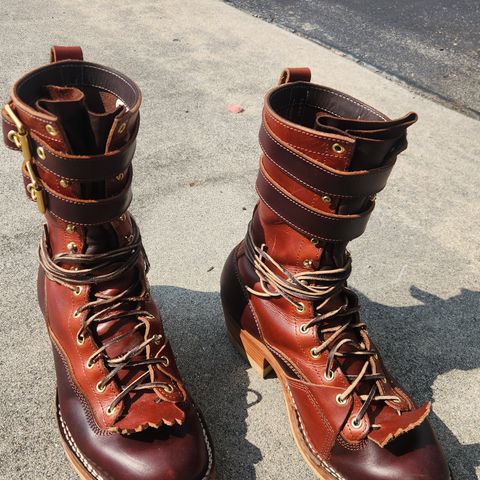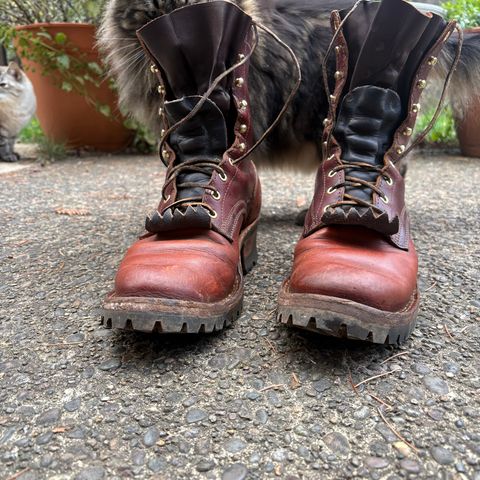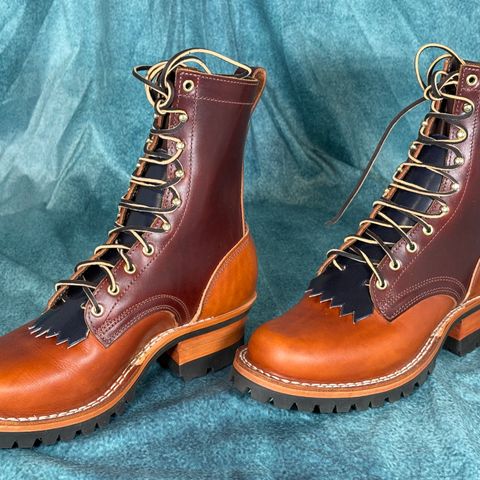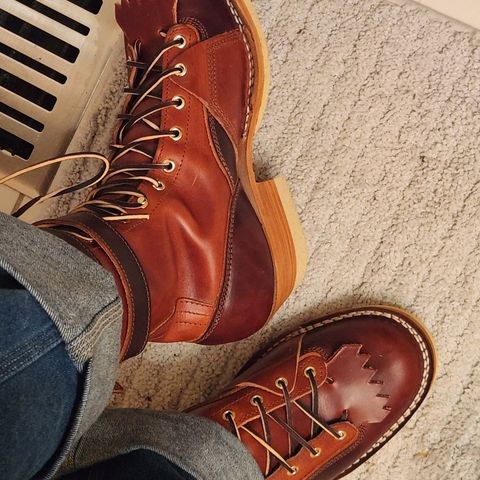About
Wickett & Craig Chestnut Oiled Latigo is a color variation of oiled latigo leather produced by Wickett & Craig, an American vegetable tannery. The leather is hot-dipped in a proprietary mix of oils, waxes, and tallows, resulting in a strong, pliable material with weather-resistant properties. As one of the lighter colors in the oiled latigo line, chestnut displays a rich pull-up effect and strong character, with color variations that develop distinctively with age and use.
About
Wickett & Craig Chestnut Oiled Latigo is a color variation of oiled latigo leather produced by Wickett & Craig, an American vegetable tannery. The leather is hot-dipped in a proprietary mix of oils, waxes, and tallows, resulting in a strong, pliable material with weather-resistant properties. As one of the lighter colors in the oiled latigo line, chestnut displays a rich pull-up effect and strong character, with color variations that develop distinctively with age and use.
Founded in 1867 and now located in Curwensville, Pennsylvania, Wickett & Craig is one of only two remaining vegetable tanneries in the United States. The company produces approximately 4,500,000 square feet of leather annually using a labor-intensive, natural tanning process that takes six weeks. Chestnut oiled latigo represents one of the tannery's signature color offerings, combining traditional vegetable tanning methods with hot-stuffing techniques that saturate the leather with oils and waxes.
Product specifications
Wickett & Craig chestnut oiled latigo is sold by side and back, with sides averaging 24-27 square feet and backs averaging 18-20 square feet. The leather is available in weights ranging from 2-3 oz. to 12-14 oz., accommodating applications from lightweight goods to heavy-duty straps and footwear. Custom splitting and refinishing services are available to meet specific project requirements.
The chestnut color is one of five colors in the Wickett & Craig oiled latigo line, which also includes Tan, Burgundy, Medium Brown, and Black. As a lighter color, chestnut exhibits more pronounced pull-up effects and color variation compared to darker shades. The leather is priced by square foot with three quality grades: Standard grade ranges from $241-$274, Utility grade from $225-$258, and Special grade from $211-$241.
Manufacturing process
The production of chestnut oiled latigo begins with Wickett & Craig's vegetable tanning process, which uses tannins derived from Mimosa and Quebracho tree bark. Raw hides from North American cattle of European stock undergo pre-tanning for two days, involving rehydration and hair removal. The tanning process uses 72 vats and takes two weeks, with hides soaking in tanning liquor to achieve the vegetable-tanned base.
Following tanning, the leather undergoes drum dyeing to achieve the chestnut color shade. The distinguishing characteristic of oiled latigo is the subsequent fat-liquoring and hot-stuffing process, where the vegetable-tanned leather is hot-dipped in a special proprietary blend of oils, waxes, and tallows. This treatment fully conditions the leather and imparts its characteristic depth of color, with the final chestnut tone influenced by both the dyes applied and the oils and waxes used in the hot-dipping.
The leather is then toggle dried in a climate-controlled space for approximately three days before undergoing finishing with wax and polyurethane spray, followed by ironing. The complete process takes approximately six weeks from raw hide to finished leather.
Characteristics
Chestnut oiled latigo exhibits several defining physical characteristics typical of lighter-colored oiled latigo leathers. The leather is strong and pliable with a fully conditioned texture and high oil content that can cause leaching, particularly in warmer conditions or when new. The material is weather-resistant and water-repellent, able to repel water while maintaining its structure.
As a lighter color, chestnut displays a particularly rich pull-up characteristic where stressed areas temporarily lighten in color, revealing the natural grain and depth beneath the surface. This pull-up effect is more pronounced in chestnut than in darker colors like Medium Brown or Black, creating distinctive visual character that varies across the hide.
The leather develops a patina with use, slowly darkening over its lifetime. Boots and goods made from chestnut oiled latigo gain character and uniqueness as they age, with the vegetable-tanned material developing a rich patina. The high oil concentration highlights the grain and character while providing natural water resistance. However, lighter colors may show marks, scuffs, or stains more readily than darker leathers, though regular conditioning greatly mitigates these visible effects.
Applications
Chestnut oiled latigo serves multiple applications in leather goods manufacturing. The material is particularly suitable for strap goods including belts, harnesses, laces, and straps, where its strength and pliability provide durability under repeated flexing and tension. When split to lighter weights, the leather works well for shoes, bags, and cases while maintaining its characteristic properties.
Heritage boot manufacturers including Nick's Boots and Caswell Boot Company use Wickett & Craig chestnut oiled latigo for premium work and heritage boot construction. The leather's combination of strength, water resistance, and distinctive aging characteristics makes it appropriate for footwear subjected to demanding conditions. The pronounced pull-up effect and rich patina development of the chestnut color make it a desirable choice for custom and made-to-order heritage footwear.
Small leather goods manufacturers also specify the material for products where the leather's lighter color, pull-up effect, and patina development are desirable features. Traditional applications extend to equestrian equipment such as saddle strings and cinches.
Care and maintenance
Chestnut oiled latigo requires specific care to maintain its condition and appearance. The leather should be cleaned with warm water and mild saddle soap, avoiding harsh chemicals that can strip the natural oils. Conditioning every six to 12 months helps maintain the leather's suppleness and mitigates visible wear, marks, and scuffs that may be more apparent on lighter colors.
Although the leather has water-repellent properties due to its high oil content, vegetable-tanned leather is not naturally water-resistant. Proper care requires protection from excessive moisture and storage indoors, away from humidity that can affect the leather's condition. For additional water resistance, beeswax can be applied to the leather's surface, though this will alter the appearance and patina development characteristics.
Due to the high oil content, the leather cannot be tooled or stamped for decorative leather work. The chestnut color may show more marks, scuffs, or stains than darker colors, though conditioning will greatly mitigate these effects. Users should expect the boots or goods to slowly darken over their lifetime as the leather develops its natural patina.
References
"Oiled Latigo". Wickett-Craig. Retrieved October 10, 2025.
"Vegetable Tanning". Wickett-Craig. Retrieved October 10, 2025.
"Made to Order - Wickett & Craig - Tan Oiled Latigo". Nick's Boots. Retrieved October 10, 2025.



































































